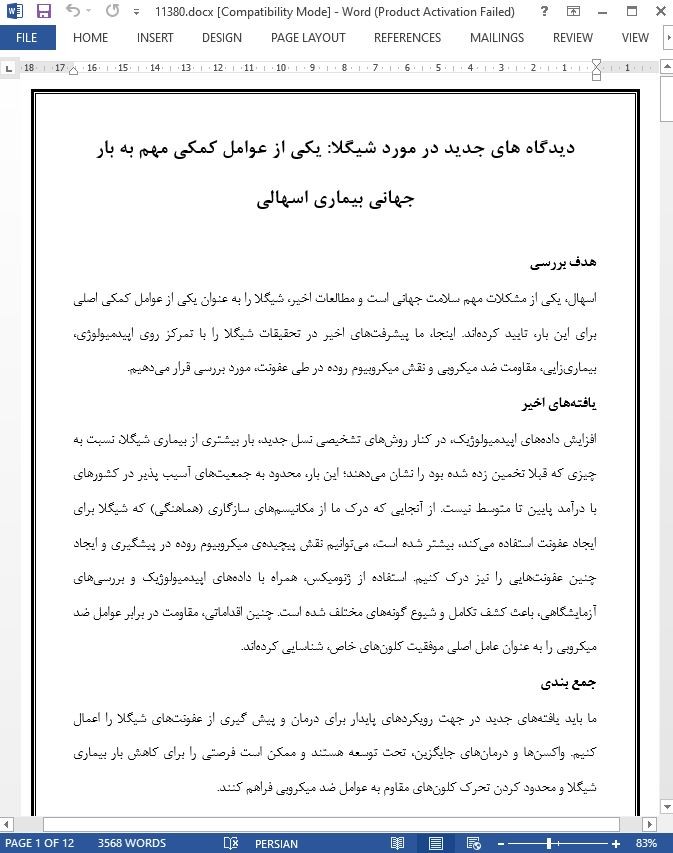
دیدگاه های جدید در مورد شیگلا: یکی از عوامل کمکی مهم به بار جهانی بیماری اسهالی
هدف بررسی اسهال، یکی از مشکلات مهم سلامت جهانی است و مطالعات اخیر، شیگلا را به عنوان یکی از عوامل کمکی اصلی برای این بار، تایید کرده اند. اینجا، ما پیشرفت های اخیر در تحقیقات شیگلا را با تمرکز روی اپیدمیولوژی، بیماری زایی، مقاومت ضد میکروبی و نقش میکروبیوم روده در طی عفونت، مورد بررسی قرار می-دهیم.
یافته های اخیر افزایش داده های اپیدمیولوژیک، در کنار روش های تشخیصی نسل جدید، بار بیشتری از بیماری شیگلا، نسبت به چیزی که قبلا تخمین زده شده بود را نشان می دهند؛ این بار، محدود به جمعیت های آسیب پذیر در کشورهای با درآمد پایین تا متوسط نیست. از آنجایی که درک ما از مکانیسم های سازگاری (هماهنگی) که شیگلا برای ایجاد عفونت استفاده می کند، بیشتر شده است، می توانیم نقش پیچیده ی میکروبیوم روده در پیشگیری و ایجاد چنین عفونت هایی را نیز درک کنیم. استفاده از ژنومیکس، همراه با داده های اپیدمیولوژیک و بررسی های آزمایشگاهی، باعث کشف تکامل و شیوع گونه های مختلف شده است. چنین اقداماتی، مقاومت در برابر عوامل ضد میکروبی را به عنوان عامل اصلی موفقیت کلون های خاص، شناسایی کرده اند.
جمع بندی ما باید یافته های جدید در جهت رویکردهای پایدار برای درمان و پیش گیری از عفونت های شیگلا را اعمال کنیم. واکسن ها و درمان های جایگزین، تحت توسعه هستند و ممکن است فرصتی را برای کاهش بار بیماری شیگلا و محدود کردن تحرک کلون های مقاوم به عوامل ضد میکروبی فراهم کنند.
نتیجه گیری
ترکیب مطالعات اپیدمیولوژیکی بزرگتر، تکنولوژی های in vitro پیچیده تر و ژنومیکس، شواهد بی سابقه ای را در مورد موفقیت جنس شیگلا ارائه داده است. این ها می توانند برای توسعه ی واکسن های بعدی و درمان های جایگزین، ارزشمند باشند. یعنی، واکسن های شیگلا باید ترفندهای بیشمار عوامل بیماریزا برای دستکاری پاسخ ایمنی و همچنین اپیدمیولوژی که به سرعت در حال تغییر است را مدنظر قرار دهند. درمان های جدید می-توانند از تجسم دقیق بیماری زایی شیگلا و برهم کنش های آن با میکروبیوتای روده سود ببرند. این ابزارها باید تسریع شوند تا جریان روزافزون ایجاد مقاومت آنتی بیوتیکی در کلون های شیگلا مهار شود. تحقیقات شیگلا به یک وضعیت محوری رسیده اند و ما اکنون باید دانش، فناوری ها و تجربه ی خودمان را برای کاهش بار این عامل بیماری زای باکتریایی به کار ببریم.
Purpose of review Diarrhoea is a major global health problem, and recent studies have confirmed Shigella as a major contributor to this burden. Here, we review recent advances in Shigella research; focusing on their epidemiology, pathogenesis, antimicrobial resistance, and the role of the gut microbiome during infection.
Recent findings Enhanced epidemiological data, combined with new generation diagnostics, has highlighted a greater burden of Shigella disease than was previously estimated, which is not restricted to vulnerable populations in low-middle income countries. As we gain an ever more detailed insight into the orchestrated mechanisms that Shigella exploit to trigger infection, we can also begin to appreciate the complex role of the gut microbiome in preventing and inducing such infections. The use of genomics, in combination with epidemiological data and laboratory investigations, has unravelled the evolution and spread of various species. Such measures have identified resistance to antimicrobials as a key contributor to the success of specific clones.
Summary We need to apply novel findings towards sustainable approaches for treating and preventing Shigella infections. Vaccines and alternative treatments are under development and may offer an opportunity to reduce the burden of Shigella disease and restrict the mobility of antimicrobial resistant clones.
CONCLUSION
The combination of larger epidemiological studies, more sophisticated in-vitro technologies, and genomics have provided unprecedented insights into the success of the genus Shigella. These could be invaluable to the development of future vaccines and alternative therapies. Namely, Shigella vaccines should account for the pathogen’s numerous tricks to manipulate the immune response as well as the rapidly changing epidemiology. Novel therapies could benefit from the detailed portrayal of Shigella’s pathogenesis and interactions with the gut microbiota. These tools need to be accelerated to stem the tide of increasingly antimicrobial resistant Shigella clones. Shigella research has reached a pivotal state, and we now need to apply our knowledge, technologies and experience to reduce the disease burden of this bacterial pathogen.
مقدمه
نکات کلیدی
بیماری زایی شیگلا: تعادل بین قدرت عفونت زایی (ویرولانس) و حفاظت
مرزهای جدید: برهم کنش شیگلا با میکروبیوم روده
تغییر اپیدمیولوژی و چالش مقاومت به چند دارو
نتیجه گیری
INTRODUCTION
KEY POINTS
SHIGELLA PATHOGENESIS: THE BALANCE BETWEEN VIRULENCE AND PROTECTION
NEW FRONTIERS: SHIGELLA’S INTERACTION WITH THE GUT MICROBIOME
CHANGING EPIDEMIOLOGY AND THE CHALLENGE OF MULTIDRUG RESISTANCE
CONCLUSION
- اصل مقاله انگلیسی با فرمت ورد (word) با قابلیت ویرایش
- ترجمه فارسی مقاله با فرمت ورد (word) با قابلیت ویرایش، بدون آرم سایت ای ترجمه
- ترجمه فارسی مقاله با فرمت pdf، بدون آرم سایت ای ترجمه


